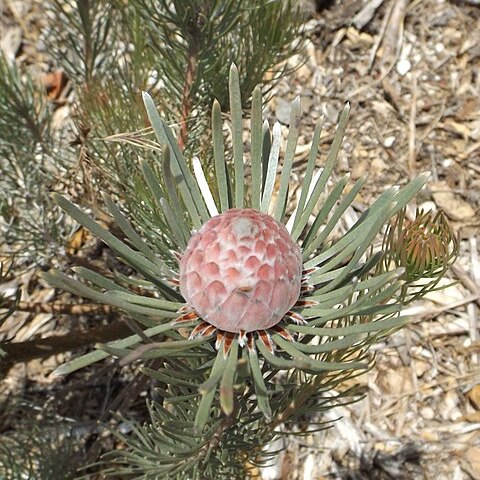Shrubs up to 2 m, silvery, developing from a single stem below, often in dense stands. Branches fairly stout in the female plant, more slender in the male plant, erect, tomentose, arising from immediately below the previous years inflorescence singly or in pairs in female plants and in up to 15 cm male plants. Leaves linear or linear-oblanceolate, obtuse at the apex, with a small blunt mucro, narrowing towards the base, clothed on all surfaces with a short adpressed-silvery pubescence, semi-erect, of male plants 2.8-4.2 cm long, 2.5 mm broad, of female plants 4.5-5.9 cm long, 1.8-4 mm broad. Involucral leaves not coloured, similar to the stem leaves but more crowded, longer and broader, patulate, in male plants up to 4.4 cm long, 3.5 mm broad, in female plants up to 6.2 cm long, 5.3 mm broad. Male inflorescence solitary, terminal, hemispherical, greenish yellow, 8 mm long, 1.5 cm diam., giving off a faint but pleasant odour. Basal bracts lanceolate, acute, pubescent, ciliate, brown, about 53 cm number, 5 mm long, 1.3 mm broad. Floral bracts oblanceolate, concave, subacute at the apex, ciliate, pubescent and coloured above, 3 mm long, 1.2 mm broad. Floral bud arched, densely pubescent, 5 mm long. Perianth tube 2 mm long, pubescent above, glabrous below, tapering to the base, closed at the throat by a unique fleshy process on the posterior segment. Claw 2 mm long, densely pubescent, recurved 45-90°. Limb 1.7 mm long, narrow, concave, densely white-pubescent. Anther 1.2 mm long, linear, slightly curled upwards, stripped of pollen at anthesis. jpPollen triangular in polar view with blunt apices and sides 34 µ long. Stigma 1 mm long, clavate, acting as a pollen presenter. Style 4 mm long, glabrous and narrower above, pubescent for a length of 0.5 mm at the base and adnate with the perianth tube for a length of 0.8 mm below this, bent at the throat of the perianth tube. Anterior hypogynous scales absent or connate with the lateral and anterior perianth segments. Posterior hypogynous scales adnate with the lateral perianth segments for a length of 1.2 mm, free above for a length of 0.3 mm. Receptacle 4 mm long, 2.5 mm diam., ovoid. Female inflorescence 2.6 cm diam., solitaty, terminal, globose, exceeded by the involucral leaves but not hidden from above, the upper half bearing the very hairy florets forming greenish yellow stars contrasting with the silvery hairs of the bracts, arranged in 5 spirals of about 15 cm each, the lower half closely imbricated by the basal bracts. Basal bracts about 10 mm long, 3.3 mm broad, about 114 cm number, lanceolate, acute, pubescent, ciliate, purplish brown, increasing in size, becoming broad at the base and sub-caudate. Floral bract 1.1 cm long, 8.5 mm broad, ovate, acute at the apex, ciliate, very densely pubescent. Floral bud 1.05 cm long, arched, densely pubescent. Perianth tube 1 cm long, deeply divided, densely clothed with very long straight white hairs, glabrous below. Claw 2 mm long, long-white-pubescent, recurved 90°. Limb 1.8 mm long, linear, with the pubescence decreasing in length towards the apex. Staminode 1 mm long. Ovary 1 mm long, pubescent. Style 1.1 cm long, glabrous, swollen at the apex and base, otherwise evenly terete. Stigma 0.7 mm diam., terminal. Hypogynous scales 1 mm long, subulate, yellow. Nectar seen at the throat of the perianth tube. Receptacle 1.5 cm long, 7 mm diam., clavate. Mature female cone 3.3-4.1 cm long, 2.8-3.4 cm diam., ovoid, acute at the apex, coloured. Fruit 6 mm long, 3 mm broad, a pointed nut sparsely pubescent, sub-cylindric narrowing to the base, obtuse at the ape with a persistent style, the persistent plumed perianth slides up the style an acts as a parachute for wind dispersal.
More
Shrub, erect, 1-2 m high, dioecious. Leaves linear-oblanceolate, silvery hairs, 28-42 x 2-3 mm in male plants, 45-59 x 2-4 mm in female ones, glaucous, purplish grey, apex with sunken, fine point; involucral leaves larger than foliage leaves. Male flowers in terminal, turban-shaped capitula, pleasant smelling, 8 x 15 mm, greenish yellow; posterior floral segment base fleshy. Female flowers in terminal, globose capitula, 26 x 26 mm, surrounded by involucral leaves but not hidden; perianth segments fused with short plumes. Mature capitulum 33-41 x 28-34 mm, ovoid, silvery pink. Flowering time Dec. Fruit released.
Dioecious shrub to 2 m. Leaves linear-oblanceolate, silvery adpressed-hairy, 28-42 mm long (male), 45-59 mm (female), involucral leaves larger. Male flower heads ± 15 mm diam., female ± 26 mm diam., slightly scented.


